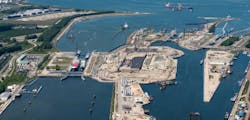Building Momentum: Saint-Gobain's ESG leader highlights path to Net Zero for company
Truth is you can teach an old company new tricks.
Building materials manufacturer Saint-Gobain (pronounced 'san go-bahn' and many other ways) traces its roots back to 17th century France and the era of King Louis XIV. The company since has expanded around the world and has numerous plants in North America.
The leaders of Saint-Gobain believe it has survived the test of time by evolving with the times and needs of that particular era. Meet the customer where they are and make the world a better home, the latter of which serves as its corporate motto.
EnergyTech recently spoke with Dennis Wilson, who is vice president of ESG (environmental, social and governance) and managing director of Saint-Gobain Circular Economy Solutions, North America. He gave some clarity and context around his company’s multiple energy efficiency, recycling and electrification moves at many of its plants on the continent, including Montreal, New York and California.
Already this year, Saint-Gobain has announced at least five major projects to improve efficiencies at several North America plants. These include recycling operations and the gypsum-wallboard plants run by subsidiary CertainTeed.
Construction contributes a large part of industrial and commercial greenhouse gas emissions. Two years ago, the company targeted 2030 as the date to have reduce direct and indirect CO2 emissions by 33 percent compared with 2017.
And Saint-Gobain sees no silver bullet to Net Zero, but will take multiple paths to reach that goal by 2050.
“Sustainability is really about resource efficiency,” Wilson said in his exclusive chat with EnergyTech. “The companies which manage resources are better performers. This isn’t a flavor of the month.”What he means by that last line was chasing splashy projects which might get bigger headlines but truly make little dent in combating climate change. Saint-Gobain is focused in improving the energy footprint of its plants from the inside out.
Earlier this month, Saint-Gobain's building products subsidiary CertainTeed LLC announced it was installing energy efficiency controls at its New York gypsum plant in Buchanan. New grinding control technology will utilize variable frequency drives and possibly save plant energy consumption to the tune of 700 MWh annually.
“The first stop on the path to Net Zero is energy efficiency,” Wilson noted. “You don’t have to offset something that doesn’t exist (if using less energy cuts emissions). We’re focused on that space.”
In Montreal, CertainTeed will invest close to C$90 million (nearly half of that funded by Quebec government grants) to shift from gas-fired power to electrification for equipment functions.
One solution at one plant doesn’t work everywhere. Wilson acknowledged a movement by many for a complete turn to electrification in manufacturing processes, but that isn’t always a fit.
It might be new variable frequency drives in one location, updated compressors at another. Process changes all around.
“Any manufacturing plant with a high thermal load, you’d have to go through different processes for electrification to full work,” he said. “We need to see (electrification advancements) mature over time.”
Saint-Gobain is considering fuel resources moving from natural gas and other fossil-fired power to hydrogen and biofuels. Time will tell where these changes fit best, and on-site power renewables like solar can certainly assist in the decarbonization.
Renewable energy power purchase agreements (PPA) are part of the company approach to offsetting greenhouse gas emissions, Wilson pointed out. Saint-Gobain did a large off-site, virtual PPA for a wind farm developed by and contracted with Invenergy. Some on-site renewables are part of the equation, but are not regarded as substantial aids in the mission to completely offset carbon emissions.
“Onsite power is a complex picture for us,” Wilson said, reaffirming the company’s commitment to ‘efficiency first.’ “The challenge with on-site solar is it tends to be a drop in the bucket in the greater scheme of energy use in a plant.”
But Saint-Gobain will certainly consider on-site alternatives such as microgrids. It has watched with alarm as the overburdened grid, in markets such as Texas, struggle with high demand, record temperatures and resiliency issues.
“We have plans to deal with outages, curtailments...and that’s something we’re looking at very deeply,” he replied. “We have a partnership with Stem to locate on-site energy effort at our Garden Grove facility in California.”
At that plastics plant, Stem’s energy storage is powered by Athena, an artificial intelligence (AI) format which learns energy use patterns and then manages grid reliance automatically. Athena activates the battery storage system before costly demand spikes can occur, according to the company.
Stem delivers this as an energy as a service solution, which required no upfront capital cost from Saint-Gobain.
And energy efficiency is kind of pay it forward thing. Saint-Gobain’s building products assist in less leaky building constructions which, altogether, can help avoid 1.3 billion metric tons in CO2 emissions.
“We view it as a good business and as the good, long-term management of our business,” Wilson said.
-- -- --
(Rod Walton, senior editor for EnergyTech, is a 14-year veteran of covering the energy industry both as a newspaper and trade journalist. He can be reached at [email protected]).






